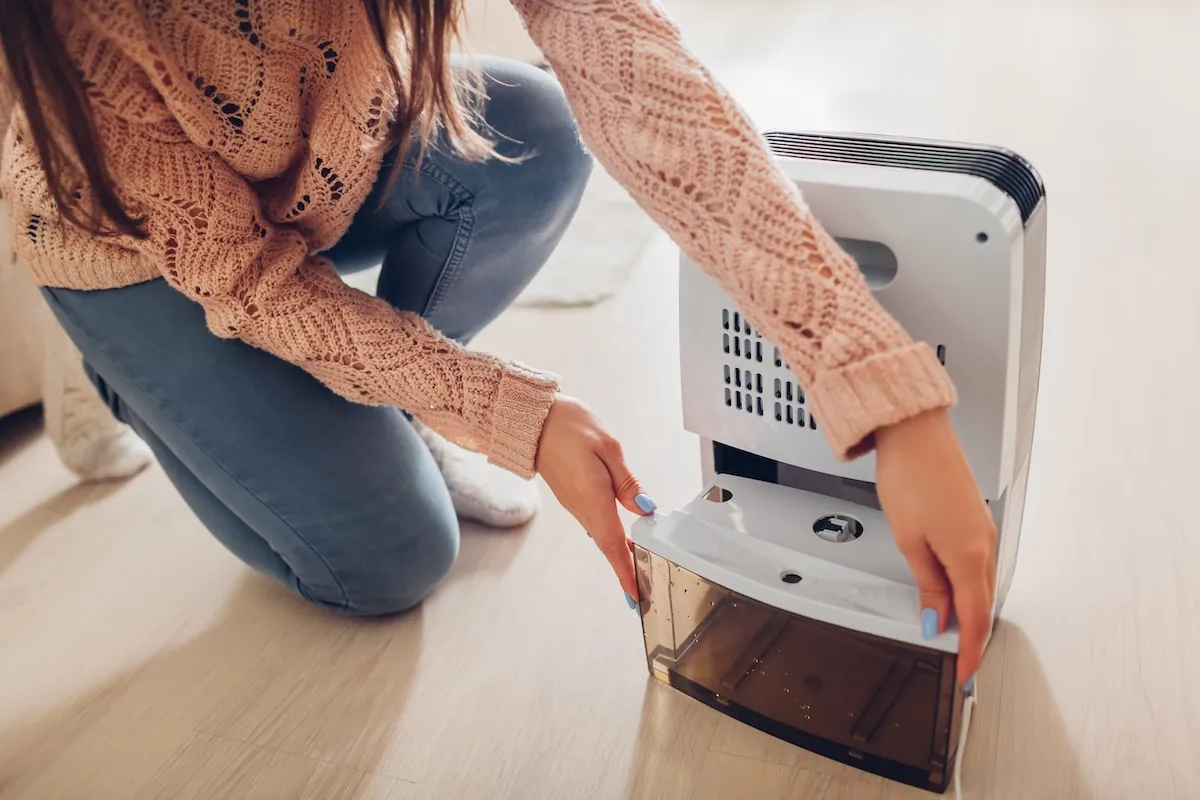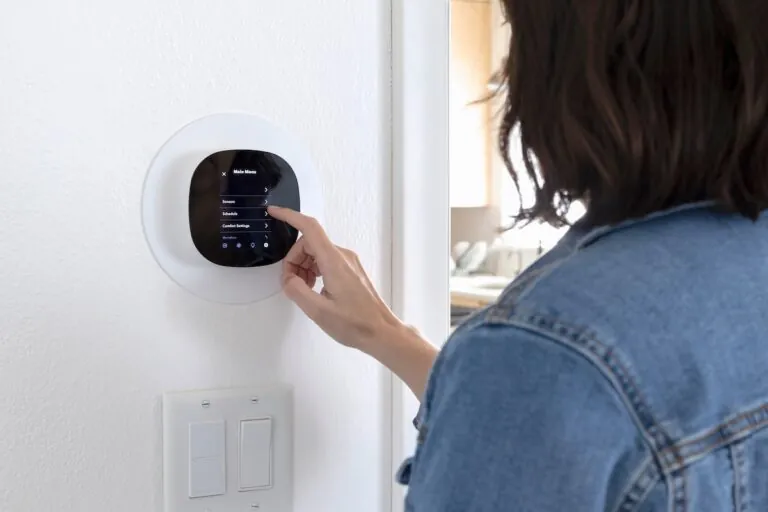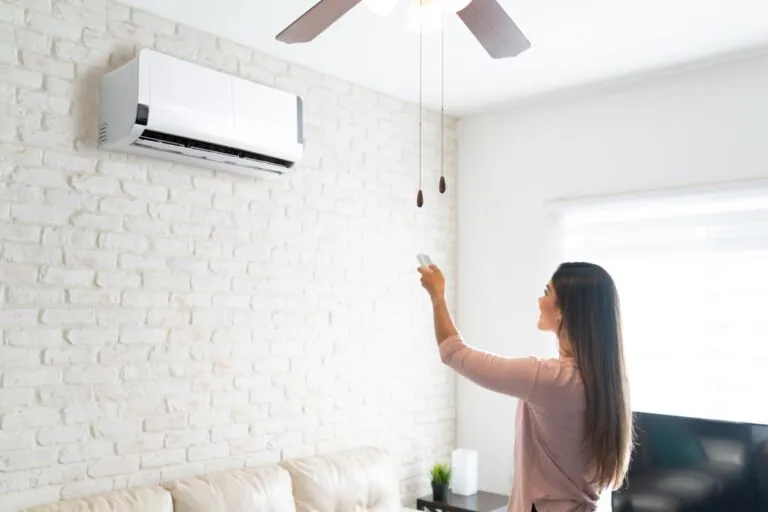If you’re wondering what does a dehumidifier do and whether it’s worth using in your home, you’re not alone. These compact devices serve a big purpose: they pull excess moisture from the air, helping create a healthier, more comfortable indoor environment.
In this blog, you’ll learn:
- How a dehumidifier works and what it actually does
- Key benefits for comfort, air quality, and home protection
- When and where to use one in your home
👉 How Dehumidifiers Work
A dehumidifier works by pulling in humid indoor air, removing excess moisture, and then returning dry air to your living space. It helps reduce relative humidity to a more manageable level, typically between 30% and 50%.

Moisture Removal Process
Inside the unit, warm, humid air is drawn in and passed over refrigerated coils, which cool the air and cause water vapor to condense. This moisture collects in an internal tank or drains through a connected hose, depending on the system’s design. The now-dry air is then reheated slightly and returned to the room, helping maintain a consistent and comfortable humidity level. This process repeats automatically, cycling based on your set humidity preferences until the ideal environment is reached.
Different Types of Dehumidifiers
There are several types of dehumidifiers available, each suited to different spaces and needs. Portable models are ideal for single rooms, such as bedrooms or basements, and offer simple plug-and-play convenience. Whole-home systems, on the other hand, are integrated into your HVAC system to manage moisture across the entire house. Some advanced units also include features like automatic drainage, built-in humidistats, air filters, and programmable cycles for maximum control and ease of use.
Ideal Placement
To get the best results, place dehumidifiers in areas prone to high humidity or poor air circulation. Basements, bathrooms, laundry rooms, and crawl spaces are frequent trouble spots where moisture tends to accumulate. Homes in humid climates or with limited ventilation may benefit from year-round use, especially in spaces where mold, mildew, or musty odors are common. Proper placement ensures the system captures moisture efficiently and keeps the surrounding environment healthy.
✅ 5 Stand-Out Benefits of Using a Dehumidifier
If you’re still on the fence, here’s a breakdown of the biggest advantages a dehumidifier offers:

- Prevents mold and mildew: By reducing excess humidity, a dehumidifier limits the conditions that allow mold and mildew to thrive in bathrooms, basements, and hidden corners.
- Improves indoor air quality: Less moisture in the air means fewer dust mites, allergens, and musty odors that can aggravate allergies and asthma.
- Protects home structure: Over time, high humidity can cause paint to peel, wood to warp, or insulation to degrade—dehumidifiers help prevent all of this.
- Enhances comfort: Humid air often feels warmer and heavier, so removing moisture can make your home feel cooler and more breathable, even without adjusting the thermostat.
- Supports HVAC performance: When humidity levels are balanced, your air conditioner doesn’t have to work as hard, which can improve efficiency and reduce energy bills.
🤔 When Should You Use a Dehumidifier?
Not every home needs constant dehumidification, but in certain scenarios, it can make a big difference.
- Seasonal humidity: Spring and summer bring higher humidity, especially in areas with frequent rain or high outdoor moisture. As temperatures rise, warm air holds more moisture, making indoor spaces feel sticky and uncomfortable. A dehumidifier helps maintain indoor comfort by pulling excess moisture from the air, which not only improves breathability but also supports better sleep, reduces sweating, and keeps your cooling system from working overtime.
- Basement dampness: Basements are notorious for being cool and damp due to their underground location and reduced airflow. Without active moisture control, they often develop musty smells, condensation on walls, or visible mold in corners and storage areas. A dehumidifier helps reduce odors, prevent damage to belongings, and protect the structural integrity of flooring, drywall, and insulation over time—especially in homes that use basements for living or storage space.
- Post-leak recovery: If your home has experienced a leak, burst pipe, or water intrusion, moisture can linger in walls, floors, or insulation long after surface water has been cleaned up. A dehumidifier speeds up the drying process and helps prevent long-term issues like warping, mildew, and structural decay. It’s an essential tool for minimizing damage, reducing the risk of mold growth, and restoring indoor air quality after water-related events.
💧 Signs You Might Need a Dehumidifier
Wondering if it’s time to invest in one? Watch for these signs around your home.
Visible Moisture or Condensation
Condensation on windows, wet spots on walls or ceilings, and damp floors are clear indicators that indoor moisture is too high. These signs often show up in bathrooms, kitchens, and basements.
Musty Odors
A musty or mildew smell often means there’s too much humidity trapped in a space. This can also signal mold growth in places you can’t see, like inside walls or under flooring.
Allergy Flare-Ups
If you or your family members notice increased allergy symptoms at home—such as coughing, sneezing, or skin irritation—high humidity could be contributing to indoor allergens like dust mites or mold spores.

🛠️ Dehumidifier Maintenance Tips
Keeping your dehumidifier clean and working properly is key to long-term performance.
- Empty and clean the tank: Most portable dehumidifiers collect moisture in a reservoir that needs to be emptied regularly. Clean the tank every few weeks to prevent mold buildup and bacteria.
- Change or clean filters: Many models have air filters that trap dust and particles. Check the manufacturer’s recommendations and clean or replace them regularly to maintain good airflow.
- Inspect coils and vents: Dust and debris can clog intake or exhaust vents, reducing efficiency. Wipe down coils and ensure nothing is blocking airflow around the unit.
🤝 Start Controlling Humidity Today
Understanding what a dehumidifier does is the first step toward healthier, more comfortable living. Whether you need to protect your basement, improve air quality, or support your HVAC, it’s a simple solution with long-term benefits.
Contact Genz-Ryan today to find the right dehumidifier system for your home. We’ll help you take control of humidity and create a better indoor environment for you and your family.








